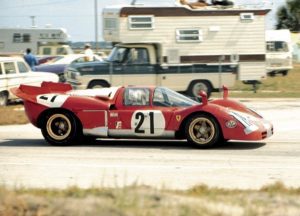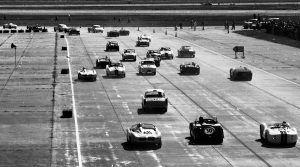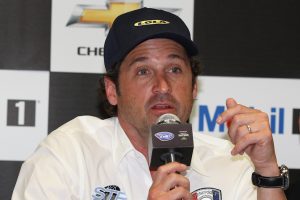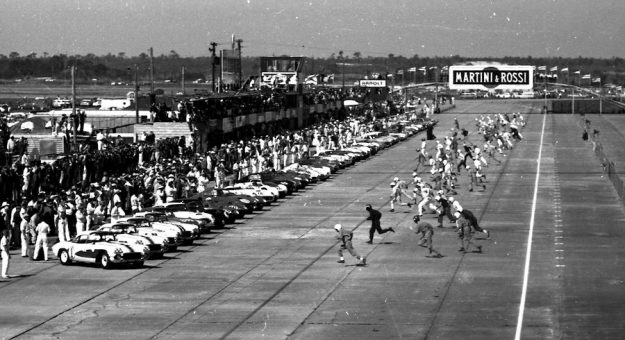
SEBRING FAST FACTS

- As the motorsports community prepares to celebrate the 70th running of the Mobil 1 Twelve Hours of Sebring at Sebring (Fla.) Int’l Raceway, here are several interesting facts and figures relating to America’s oldest endurance race:
- The 12 Hours of Sebring was not held in 1974 due to the gas crisis. Despite no race, more than 2,000 devoted fans showed up at track anyway.
- Sebring Int’l Raceway was originally a World War II B-17 training base known as Hendricks Field. During the nearly five years it was active, the base originated 488,936 flying hours, covering more than 98 million miles. One Hendricks Field B-17 known as “Lightning Jim” logged more than 8,000 hours of flying time, representing over 335 days in the air.
- The Sebring 12-hour race has been run in March every year except 1967 (April 1) and 2020 (Nov. 14).
- Steve McQueen, James Brolin, Gene Hackman, Patrick Dempsey, David Carradine, Craig T. Nelson, Dick Smothers, Jackie Cooper, Lorenzo Lamas and Paul Newman are among the many entertainers who have driven at Sebring.

Patrick Dempsey - The first Sebring-winning team to average more than 100 mph was the Ford Mk IV driven by Mario Andretti and Bruce McLaren in 1967.
- Porsche won 13 consecutive Sebring 12-hour races from 1976 to 1988. The streak was broken by Nissan in 1989, the first Japanese manufacturer to win the race overall.
- The surface of Sebring’s front straightaway is the original concrete poured in 1941 for the Hendricks Field military base.
- In 1955, six cars started the race without permission, sneaking on to the track during the Le Mans start. The cars were reserve entries that failed to qualify. After a lap around the circuit, they pulled off the track.
- Tom Kristensen became Sebring’s first six-time winner in 2012. He also set the fastest race lap six times, a Sebring record.
- During the 1960s, tech inspection took place in downtown Sebring and the cars were then driven to the track.
- Former President Jimmy Carter visited Sebring several times as a spectator. His family would travel from Georgia every March to attend the races. Other famous spectators include Apple co-founder Steve Jobs and Jim Morrison of the Doors.
- The 12 Hours was run on Sunday in 1953, ’54 and ’55. All other years it has been held on Saturday.
- Among those who have driven at Sebring that fans might not have expected: Journalist Walter Cronkite, jazz musician Allen Eager, astronaut Pete Conrad, pro football quarterback Dan Pastorini, and stock car stars Fireball Roberts, Curtis Turner, Ken Schrader and Michael Waltrip.
- Prior to 1970, Sebring used the famous Le Mans start, in which the drivers ran to their cars to start the race. The cars were lined up according to qualifying speeds from 1964-’69. Prior to 1964, cars were placed on the grid according to engine displacement. Regular qualifying began in 1970 when the rolling start replaced the Le Mans start.
- Liz Halliday’s second-place overall finish in 2006 (first in the LMP2 class) was the best finish by a female driver in the 12-hour race. Previous best was fifth by Lyn St. James in 1983.
- In 2008, Team Penske became the first racing organization to win both the 12 Hours of Sebring and the Daytona 500 in the same year.
- The youngest driver to win the 12 Hours of Sebring was John Paul Jr. in 1982 (age 22 years, 1 month). The oldest was Gianpiero Moretti in 1998 (age 58 years, 4 months).
- The Frazer Nash that won the first Sebring 12-hour classic in 1952 made only three pit stops. In recent years, the winning car typically has made 12-15 pit stops.
- The first husband-wife team at Sebring was Peggy and M.J.R. Wyllie in 1956.
- The last car to qualify outside the top 10 and then win the 12 Hours of Sebring was the Porsche 962 driven by A.J. Foyt and Bob Wollek in 1985 (qualified 13th fastest).
- During the early 1950s, armed patrols on horseback were hired to shoot stray animals that wondered on to the track (mainly hogs). Actor James Brolin struck a wild hog during practice for the 1980 race.
- Ray Crawford (1955) and George Waltman (1961 and ’63) were the only drivers to complete the entire 12 Hours of Sebring solo. Rules now prohibit that.
- In August 1952, only five months after the inaugural 12-hour race, the city of Sebring offered to give the airport back to the military. After careful consideration, the USAF declined. If the military had accepted, the Sebring 12-hour race would likely have ceased to exist after only one year.
- British driver Mike Hawthorn became the first driver to win Sebring and Le Mans in the same year (1955).
Source: Sebring Int’l Raceway
